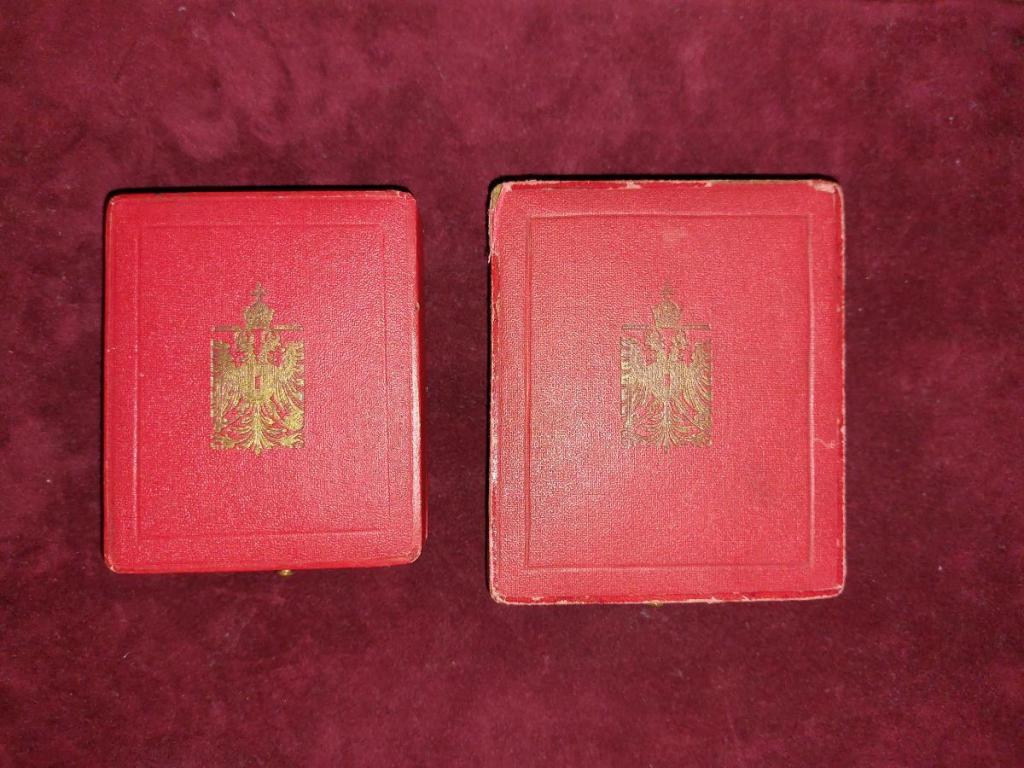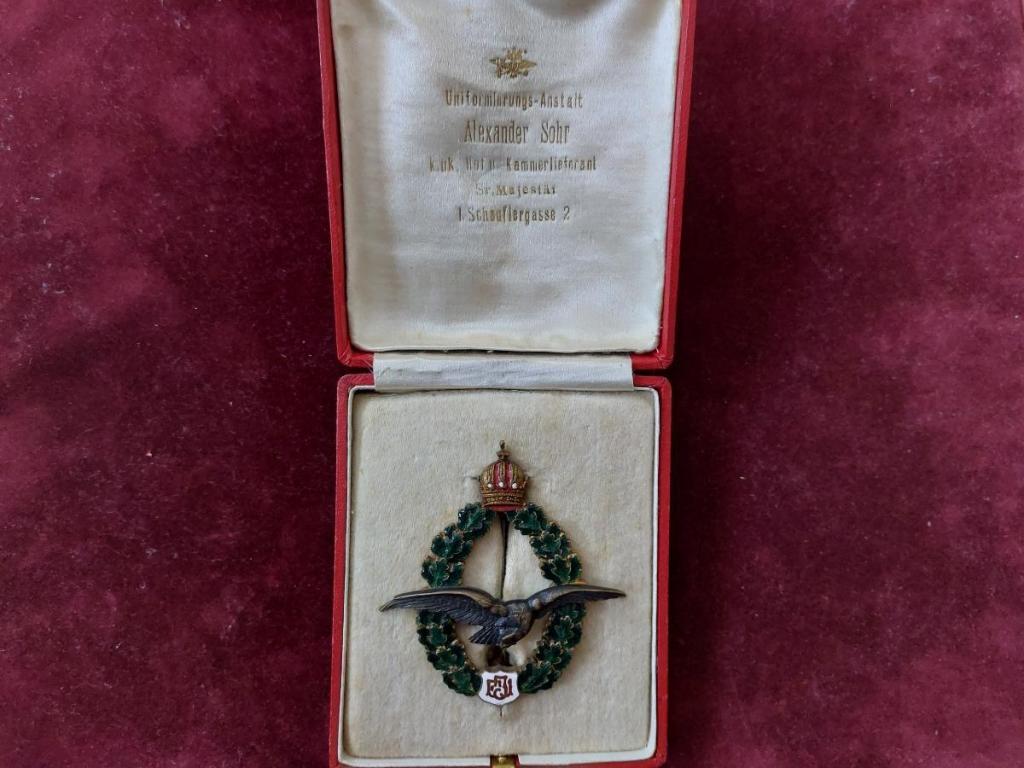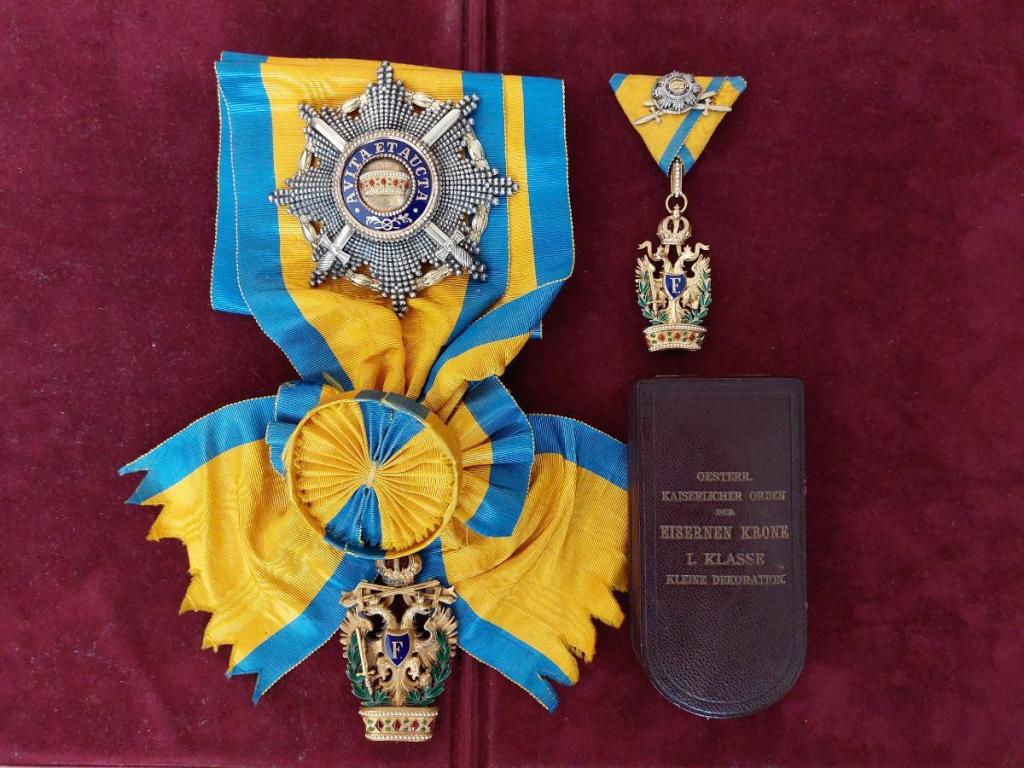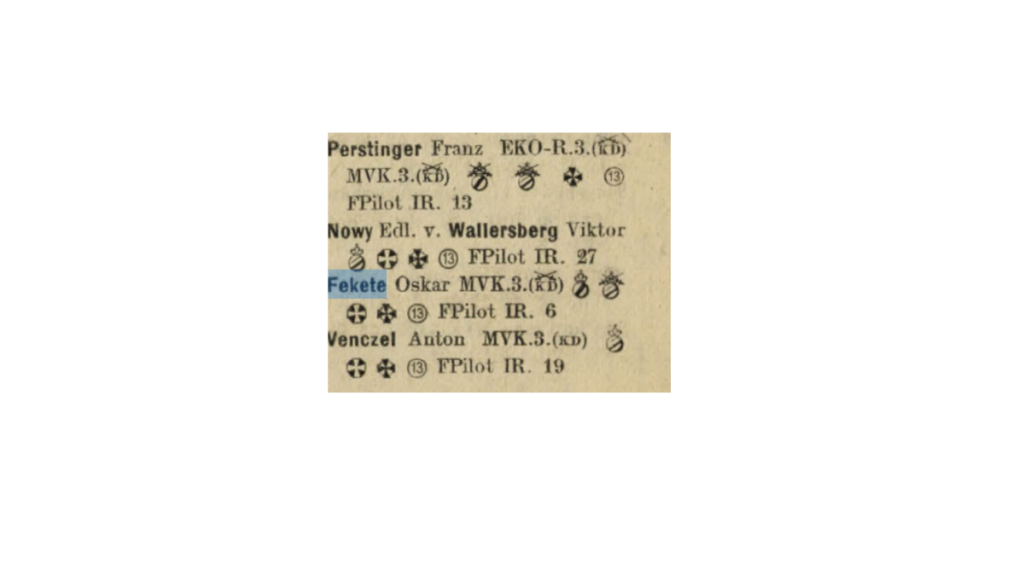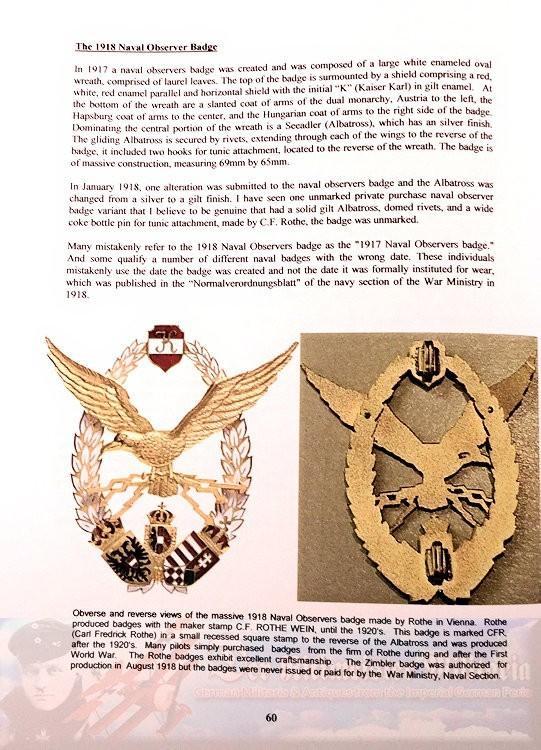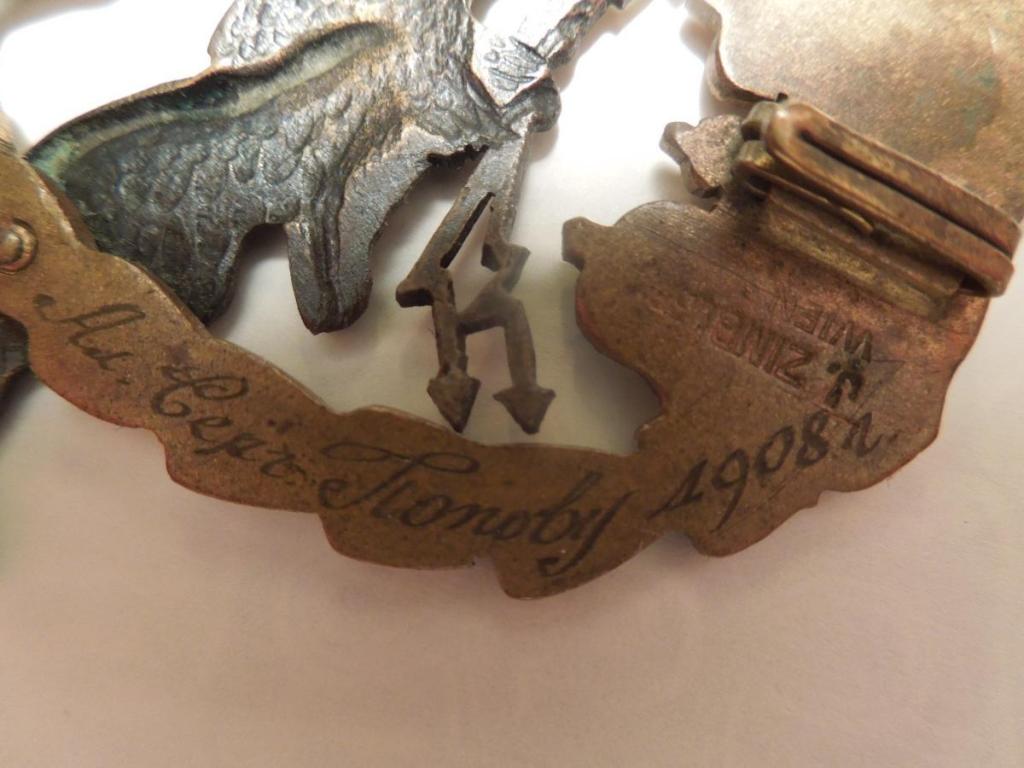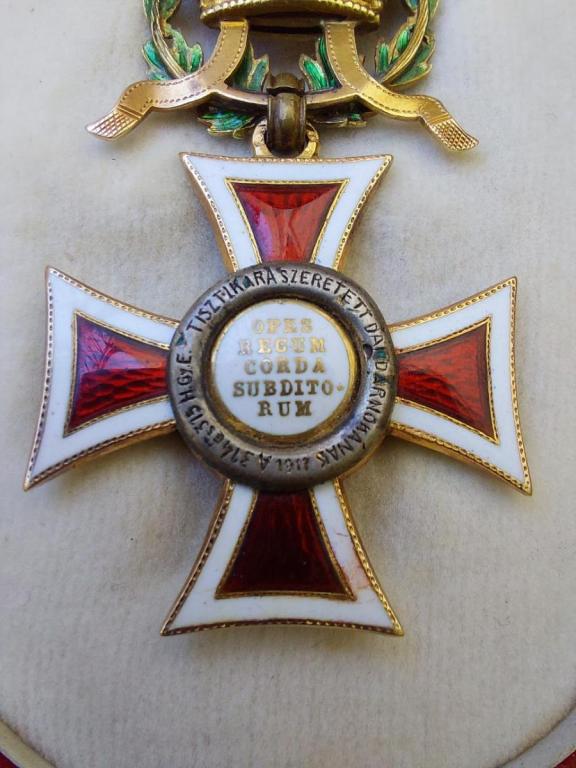
tifes
Active Contributor-
Posts
201 -
Joined
-
Last visited
-
Days Won
3
Content Type
Profiles
Forums
Blogs
Gallery
Events
Store
Everything posted by tifes
-
a iron crown with some question&opinions wanted
tifes replied to wangyaokang2003's topic in Austro-Hungarian Empire
Hi, basically everything was said by Enzo and Christian. I may just add that manufacturer is G.A. Scheid, well known maker of Red Cross decorations. His EKO has a specific design of the crown. He made these EKO3 in gilded bronze and gilded silver. Regards, Tifes (Tomas) -
Hi, Ribbon is OK, but I can´t see whether it´s from period or later one. Regards, T.
-
Once again and last time about so-called „Popov badge “. I was never arguing that engraving is late fake, but nobody knows what this engraving means as the name doesn’t fit anybody who might come into consideration. Only one person with connotation to the year 1908 (more or less) is N. E. Popov (which I’ve advocated then as I do now), but if we accept the theory that name in Russian azbuka is attributed to certain either Anton or Alexander/Alexey Sergeyevich then bad luck. There was no such person in Imperial Russian aviation. Collectors/ experts on Imperial Russia Air Force were consulted then and their finding was that during WWI on the Russian side there were more Popovs (if I remember correctly 3 were identified), but all of them joined Imperial Russian Air Force closely before or during WWI and, that´s most important, they had different names, which couldn’t anyhow fit above-mentioned engraved first named and “otchestvo”. Popov is very common name in Russia (like Johnson in US) and most probable theory was (but also unconfirmed, of course) that engraving has no connection with pilot/observer of Imperial Russian provenience but it was a gift for somebody who hasn’t anything to do with aviation and the reason for it it´s unknown. For AH collectors per se is such badge very dubious and nobody had any interest to acquire it. So it remained unsold. Period. Rothe piece is Zimbler case…again we are dealing with something, which has basically no sense. First of all, Rothe didn’t make any official badges, only Zimbler did (with exception of Badge for pilots of seaplanes 1915). Zimbler which won the state contract should deliver certain number of badges in the boxes (it´s in the contract so it can be proved, it´s not something what I made up). Most of the companies procured the boxes through subcontracting, so they contracted third party, which made tailor-made boxes for them and put the company name on inside lid. It´s like today, because it is cheaper. Other companies if they made decoration only for private purchase and in small numbers did not even bother and just purchased boxes directly from cases producers, which might be Rothe case. Second factor is human. Every pilot had more than one badge. One was officially awarded to him and the rest he bought and got them in various boxes. If the measure fit, he placed whatever badge to whatever box. He didn’t care. It´s like with cuff-links today (at least in my case). Btw, look at your pilot badge (2nd type, Karl 1917) on your picture (left). It´s in Moritz Tiller box! Tiller made uniforms, accessories to uniforms etc., but no decorations. Your badge (whoever made it, looks like Zimbler, at least it has its official form) wasn’t made by Tiller. That´s sure like tomorrow´s sunrise. I have something similar – AH pilot badge, model FJI 1913 in the box from Alexander Sohr company (similar manufacturer like Tiller). There is a comparison with AH observer badge 1917 in original Zimbler case, which is obviously smaller than Sohr box. As Sandro mentioned. This is very nice and information-oriented forum for people who like to consult phaleristics. If you are looking for "wow effect" then there is a lot of “specialized” FB group where you can get it. Opening tread with statement that in the whole world there are 2 known engraved badges of AH pilots, sorry that´s ridiculous. We are not talking about Grand Cross MMTO sets from WWI period, for god sake. At this stage I strongly recommend you to get those 2 recommended books from already mentioned Jörg C. Steiner „Das Feldpilotenabzeichen“ and „Das Luftfahrerabzeichen“. Just put it in the google and find them. You should start with them for sure. Regards, t.
- 17 replies
-
- austria-hungary
- case engraved badge;
-
(and 1 more)
Tagged with:
-
Thank you for a correction, Christian. Good to know.
-
Thank you. Yes, case by Old-Austria/Austria-Hungary became a big plus in last years but Enzo´s MVK2/KDS double awarded is really something! One of the rarest decoration of AH phaleristics, just 5 times awarded in the course of WW1. Splendid!
-
-
Old transcription of "Еевграфович" like "Михаил Еевграфович Салтыков-Щедрин" so I thought there might be "Еерч.", that what I wrote above. If you see Сергеевич, then OK for me (you are not alone, obviously E.L. sees the same), point taken. Now just to find a pilot with such name in Imperial Russia who had something to do with flying in/ or at least about 1908. I wish you good luck...or maybe Simus Rex should have a look at engraving and mystery would be solved
- 48 replies
-
- austria-hungary
- signature
-
(and 3 more)
Tagged with:
-
Sorry, but I can help myself but you said that you prepare a book about AH pilots so I assumed that your knowledge about this stuff must be at very advanced level. However, we are dealing with unreal issues like how many engraved AH pilot/observer badges are still preserved. I don't know as nobody knows it, but I can assure that´s MUCH more than 3 or 4 or 5. I don't have time to google all day long but here is another one (now in the collection of the member of this forum) https://www.sixbid.com/en/h-d-rauch/556/orden-und-ehrenzeichen/576108/orden-und-ehrenzeichen?term&orderCol=lot_number&orderDirection=asc&priceFrom&displayMode=large&auctionSessions=409|12449&sidebarIsSticky=false Oskar Fekete...whatever is the word before "1916", there is letter "Ö". How does it fit to the name "Oskar Fekete" that´s mystery for me. If you would like to know at least basic stuff about Hptm. Fekete try "Rangliste der kuk Heeres". That´s the first thing to do. See below. Regards, t.
- 17 replies
-
- austria-hungary
- case engraved badge;
-
(and 1 more)
Tagged with:
-
No, December 1909 Увлечение авиацией После этого Попов всерьёз увлёкся авиацией. В 1909 году он уехал во Францию, где стал работать механиком в авиашколе, созданной братьями Райт под Парижем, что позволяло ему проводить целые дни на аэродроме Жювизи под Парижем. Получив первые уроки лётного мастерства у шеф-пилота и первого ученика школы Райтов графа Шарля де Ламбера, француза, сына русского подданного, он 13 декабря 1909 года совершил свой первый самостоятельный вылет на аэроплане «Райт». Первый полёт длился недолго: из за неправильного движения рулями Попов опустился слишком резко и довольно сильно расшибся. Пострадал и аэроплан. Это, однако, не обескуражило Николая Евграфовича. Через месяц, оправившись от ран и ушибов, он вновь устремился в небо. А так как своего аппарата у него не было и после неудачного декабрьского дебюта в Жювизи там никто не хотел предоставить ему хотя бы ещё раз самолёт для тренировок, Попов сделал «ход конём». Он поступил на службу в… общество «Ариэль» и уехал в Канн, на, тамошний аэродром. Как служащему «Ариэля» и будущему «коммивояжеру» этого акционерного общества ему разрешили летать на «райтах», овладевать пилотским мастерством. «Здесь также не раз мне приходилось падать, — признается он несколько месяцев спустя, — расшибаться и ломать аппараты. Но я не унывал… Чинил поврежденные аппараты и снова предпринимал полёты. Таких падений было, кажется, около восемнадцати. И вот в результате я совершенно самостоятельно научился летать на труднейшем аппарате — биплане братьев Райт. Первый вполне удачный полёт он совершил почти перед самым началом авиационных состязаний в Канне.
- 48 replies
-
- austria-hungary
- signature
-
(and 3 more)
Tagged with:
-
to RedScoutNose: what you mean by phrase "here are only two known cased engraved AH pilot badges". Like two in total? Kidding right? There are dozens of them. Example of really top-notch piece: https://www.emedals.com/an-extremely-rare-gold-austrian-pilot-s-badge-to-an-austrian-ace-hauptmann-otto-jindra , which is really unique, made in gold and belonged to Captain Otto Jindra, flying ace and father of Czechoslovakian Air Force. Decorations on the picture: On the left there is badge for field-pilots (2nd type - Karl, 1917) and on the the right there is privately purchased piece from Zimbler (not officially awarded) with engraving. There is no reference to pilot name "Oskár Fekete" but if you know the provenience.
- 17 replies
-
- austria-hungary
- case engraved badge;
-
(and 1 more)
Tagged with:
-
Sorry my fault, Sandro. Yes, December 1909. https://ru.wikipedia.org/wiki/Попов,_Николай_Евграфович
- 48 replies
-
- austria-hungary
- signature
-
(and 3 more)
Tagged with:
-
To Luftmensch: Did Popov have some of the French Air Service badge? Do you know something more about it? I just found the info that he was unfit to serve as a pilot but he served “as helmsman on airship”. By other words, after his almost fatal incident in 1910 he never flew again and obviously his biography didn’t count “helmsmanship on the airship” as flying job. Nothing more and nothing less. So I suppose that you have a verified info that he has got either “l´insigne de pilote breveté de ballon dirigeable“ or „l´Insigne pour le personnel d'équipage d'avion ou de ballon dirigeable“ (bombers, gunners, photographers, mechanics, etc.). Great! Can you share this info with us? To Sandro : in 1908 he was just a mechanic. He flew from December 1909 (without license; license issued in March 1910 till May 1910) Final words: I am familiar with this “Popov badge” as it popped up on European market some 10 years ago. It was offered to more collectors, me included. It remained unsold... Training requirements for balloon pilots: Performance: 50 captive or free balloon ascents before the enemy, the former with a duration of at least two hours each. (Shorter flights with a duration of less than two hours may only then be counted if especial success or performance is achieved.) Six free balloon sorties including two under independent command. Understanding of the relationship between aircraft observation and balloon observation. Skill: Complete mastery of the entire service operation of a balloon detachment and thorough knowledge of all technical equipment. Transport matters: General knowledge of combustion engines. Balloon Theory: Basic principles of balloon construction. Characteristics and performance of introduced balloons. Knowledge of all technical equipment with a balloon detachment. Knowledge of the profiles of own and enemy aircraft. Aero Navigation: Sufficient knowledge in gas technology and its application in the balloon service. Meteorology: The most important characteristics in so far as they are necessary for balloon crews Orientation: Complete familiarity in map reading, ability to find one's way. Reconnaissance: Reporting, production of sketches, drawing of plans. Photography: Complete mastery of balloon photography, photo evaluation for target reconnaissance. Communications and fire control: Complete mastery of observation for artillery purposes. Knowledge of artillery gun control procedure and artillery methods. Organization: Knowledge of the organization of own and enemy forces as far as this is necessary for the balloon pilot. Tactics: Full understanding of battle procedures. Characteristics of air fighting tactics.
- 48 replies
-
- austria-hungary
- signature
-
(and 3 more)
Tagged with:
-
Gentlemen, just couple of words and we can move on, because this "mystery" can´t be solved as we do not have any required info. Popov was a globetrotter, interested in all sorts of things, mountaineering, polar expeditions, and sometime in 1908 he took part in the construction of an airship that was to fly to the North Pole. It never came to life. He then worked as a aircraft mechanic in Paris. He flew solo for the first time in December 1908, crashed, then tried again and obtained his aviation license in March 1910. Frankly from my personal (that I would like to underline) perspective of AH collector: The badge is an old original (and not in the best condition, to be honest) with dedication which has anything to do with k.u.k. Luftfahrtruppen, of the strange origin which can´t be explained. Popov served as a steersman on a airship of the French Air Force during WWI. Not exactly a pilot, he simply spun the rudder on the airship. No pilot's test was required for that. Honestly, no pilot (German, Austro-Hungarian and probably not even Allied) knew of his existence, he flew briefly and not very successfully before 1914 for 6 months (December 1909 till May 1910) . For the Russian Air Force, however, he is regarded as a pioneer (..because he flew). It is certain that the dedication (and I agree that it has all elements to qualify as an old one, not a modern fake) could only have been made sometime after WW1, i.e. in 1919-1929 period (until Popov's death) and nobody knows why. There might many possibilities, without any connection to AH aviation like some of his old friends from Russia living in exile in Vienna (Vienna was full of White Russian refugees after Bolshevik revolution) bought this badge (plenty of them after WW1 available), had dedication made and gave it to Popov as a gift when visiting him in Cannes, knowing that his old pale used to be a pilot. In any case I would be happy if we have an opportunity to further discuss other AH Air Force pilot badges. A few more sentences on the information sources, which play key role, in my honest opinion. I very strongly recommend the small but essential works of Jörg C. Steiner, specifically his two tiny publications (in German): „Das Feldpilotenabzeichen“ and „Das Luftfahrerabzeichen“ from 1992/1993 based on his study of particular kuk circular notes, so 10 years prior to the publication mentioned by RedNoseScout from Michael M. Edelstein „Wings of Grace and Valor it was on K.u.K. Aviation Badges“ from 2004. I do not have this publication but I tried to google it with partial success. There is a screen of page 60 which talks about Badge for observers of seaplanes of k.u.k. Navy (1918). Long story short. Info provided there is not correct and badge displayed on this page is just copy from 1970s. I am not sure that I would consider this publication as some kind of Holy Grail... Best, t.
- 48 replies
-
- austria-hungary
- signature
-
(and 3 more)
Tagged with:
-
Hi Bayern, no we do not forget about Austrian Galizia, but as I stated above any Ruthen from Austrian Galizia wouldn´t use Russian for AH badge during WW1, even when Russophile. Just to be clear: Engraving is in Russian! Cyrillic alphabet has nothing to do with it, as those three languages (Russian, Ukrainian and Bulgarian) are different. There is a different word for “year” in Ukrainian (год vs. рік) and there would be very different declination of the name “Popov” in Bulgarian. It´s like saying that Dutch, German and Danish are same because they use Latin alphabet. Regards, Tomas/Tifes
- 48 replies
-
- austria-hungary
- signature
-
(and 3 more)
Tagged with:
-
Hi Enzo, I´ve see this badge like 10 years ago (pictures below) and group of Russian speaking collectors (where I somehow belong) was consulted "what we see on the picture". Old Russian cursive might be tricky but please do not compare today's modern cursive with 19th cent. style. Reading in old Russian is quite challenging as after 1917 there was a reform in orthography and simplification of cursive for common folk (till Soviet times most of them illiterate). However, I still can see there "Ни" for Ni(kolay). With second name (отчество) is more tricky but the conclusion then and now is the same: Before 1914 there were very few Russian aviators (we are talking about individuals) and Nikolay Yevgrafovich Popov was one of those very few (...and any other Russian aviator of that name did not exist). So either it´s engraving real and it has somehow connotation to Russian pioneer airman or it´s just pure fantasy. The same concerns the concept that some pilot/observer from Austrian Galicia would speak officially Russian, moreover in time of WW1.
- 48 replies
-
- austria-hungary
- signature
-
(and 3 more)
Tagged with:
-
Hi, well, I would say…lost in translation?. I read it: „Ни. Еврч. Попову 1908 г.“, which means (to) „Ni(kolay) Yev(g)r(afovi)ch Popov 1908 g.“ („1908 g.“ stand for in year 1908, that´s correct). Nikolay Yevgrafovich Popov was a pioneer Russian aviator. His interest in flying could be dated back to 1908 when he started as mechanic in flight school of Wright brothers in Paris. He flew for the first time in 1909 and became a pilot. He returned to Russia but consequently he almost fatally crashed in 1910, survived but he couldn’t fly anymore. He moved back to France. During WWI, he served as a navigator in an airship of the French Air Force. After the war he moved to Côte d’Azur and committed suicide in 1929 as suffered from excruciating back pain as a result of his plane crash in 1910. Badge itself it´s original piece (no doubt about it) whether it was worn during WW1 by some AH flight observer is unknown but Popov has nothing to do with it and that´s also sure. Popov was on other side, with the Triple Entente and never had any business with AH Luftfahrtruppen. It might be that somebody (maybe old Austrian aviator friend from pre-1914 period?) gave it to him as gift in years after WW1 or there might be another story. Best, Tomas
- 48 replies
-
- austria-hungary
- signature
-
(and 3 more)
Tagged with:
-
Hi, first of all, Sandro is right. I don't know whether this thread could be moved to its "own box", especially when there is a follow-up. RedNoseScout please "copy-paste" this conversation to new thread and there we can go on. In any case I am quite confused hearing about "Godet´s AH pilot badges". What is that? There were 6 pilot/observer AH badges. Just one (badge for pilots of seaplanes - k.u.k. Navy 1915) was made in silver by company Franz Tiller und Neffe, rest in gilded bronze by Zimbler (including 1918 badges for pilots of seaplanes and for observers of seaplanes, which were manufactured but never delivered to kuk War Ministry because the war ended and the Empire with it). It´s crystal clear that badge as presented by RedNoseScout is in silver and with dedication. It´s private piece and as such it was never awarded. It must be bear in mind that pilot badges were qualification badges and strict criteria had to be met by pilot to get a badge. Private pieces (in common metal, silver, gold) were made by various companies and they differed in their design (sometimes quite significantly). To conclude: I can´t see any hallmarks/ maker´s mark on the above displayed privately made "Feldpilotenabzeichen 1913" (The Field Pilot's Badge, model 1913) but I would say with quite high certainty that it´s "old good Austrian work". Honestly, I do not know any AH pilot badges made by Godet. Even after "Anschluss" it was predominantly Austrian BSW who made pilot/observer AH badges for re-activated former AH pilots/observers (NCOs/officers) who joined Luftwaffe, mostly as instructors for young pilots. Regards, Tomas
-
The quality of this MVK3/KD is much more superior compared to post-WW1 pieces. Lack of hallmark/maker´s mark (or both) means basically nothing and to classify decorations accordingly is a bit short-sighted. There might be many reasons why hallmark is missing. KD looks like gold plated to me, decorations is sewed in the the ribbon and general look and the whole execution is good. It´s certainly so-called 3rd model (1866-1918), not early piece like 1870s but it might be pre-1914 production (turn of the century) or very early WW1 piece.
-
HI, I can´t help myself but I see rank insignia which corresponds to "Feldwebel” but József Kiss was “Stabsfeldwebel”, which looks different and you can see it on the picture. I am not an expert concerning “Kragenspiegel” but I would say that Feldwebel had lace zig-zag strip in the yellow colour (keisergelbe) and the stars were in white as Bayern stated. I assume that you just want to show how such insignia was looking like and you are not saying that this one belonged to J. Kiss. However, that privately made pilot badge in silver pictured above is really beauty and something that you can be proud of.
-
LO-knight/KD and swords with Hungarian dedication
tifes replied to tifes's topic in Austro-Hungarian Empire
Translation wasn't provided by Pannonia Terra Numizmatika and it wasn't a question indeed. -
Hello, I have this decoration for ages. It´s obviously the Austrian Imperial Order of Leopold - knight cross (in gold) with War Decoration and swords where the laurel wreath around the reverse side medallion has been replaced by a silver circle with a description: “A 314 és 315 H.Gy.E. TISZTIKARA SZERETETT DANDÁRNOKÁNAK 1917”, which I read (or better said my Hungarian colleague read it for me as): "To his beloved Brigade Commander from the Officer´s corps of 314th and 315th Honvéd Infantry Regiments". Could you please verify whether it´s correct (translation made by native Hungarian so I hope it´s OK) and of course, it would be great to identify the officer (Colonel, maybe GM) Thank you very much! Tifes/Tomas
-
Well, "non-combatant and combatant" is not correct, indeed. The original Military Merit Medal commonly known as the "Signum Laudis" was introduced by Emperor Franz Joseph in 1890 as a sign of His Majesty's Royal praise and recognition for either 1.) outstanding achievements in war or 2.) as a sign of his satisfaction for excellent service in peace. The award for wartime achievement was worn on the ribbon of the Military Merit Cross (on your picture on the right and that for service in peace on a red ribbon (on your picture on the left). Swords were introduced in December 1916 for the military action facing the enemy (only "war service").
-
It´s 2nd Class Silver Bravery Medal Franz Joseph I, dated from 1866 to 1914. Some of these medals as "leftovers" could be awarded in early period (1914-mid 1915) of WWI to the enlisted soldiers and NCOs. 2nd Class Silver Bravery Medal was also awarded to the long-serving NCOs for good conduct of the their duties (so not necessary for a bravery in combat) till 1914.
-
Silver Merit Cross 1849 + Crown - Opinions?
tifes replied to JeffV's topic in Austro-Hungarian Empire
Hi, I just see Silver Merit Cross with the Crown. It looks like WW1 version. Thousands of them were made and there were many variants, however this one looks pretty common to me. Regards, Tifes -
He was also Austrian medalist, but decorations he made just for Bulgaria.

